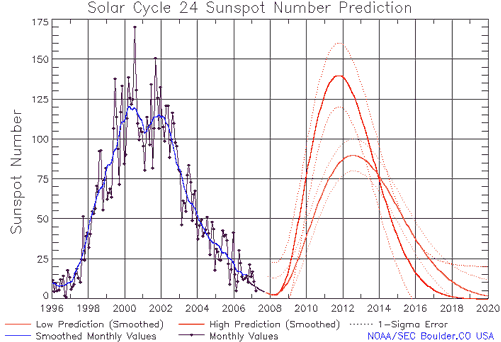Are we heading into a new Little Ice Age?
Posted on 25 October 2007 by John Cook
Solar activity is not static - it shows long term trends of brightening or cooling as well as a distinct 11 year cycle. Currently, we're at the minimum of the solar cycle with no sunspots observed over the last few weeks. With the sun on the verge of entering a new cycle, there are speculations that we could be heading into a period of lower solar activity, leading to global cooling and possibly even a new Little Ice Age. Russian scientist Habibullo Abdussamatov predicts that around 2040, the sun will cool down to Maunder Minimum levels (Abdussamatov 2005). This was a period in the 17th Century with almost no sunspots for 70 years, coinciding with the Little Ice Age. Could a cooling sun overrule anthropogenic global warming?
Predicting the next solar cycle
Solar prediction is a problematic exercise as there are no proper physical models that allow predictions of even the next cycle. Therefore predictions tend to be based on statistical inference with little in the way of physics or modelling involved. For example, longer solar cycles tend to be followed by a weaker cycle.
The closest thing to a scientific consensus on solar prediction comes from the Solar Cycle Prediction Panel, consisting of members of NASA, NOAA, ISES and other US and International representatives. In March 2007, they released a consensus statement for the amplitude of the upcoming cycle 24. Their position:
"In light of the expected long interval until the onset of Cycle 24, the Prediction Panel has been unable to resolve a sufficient number of questions to reach a single, consensus prediction for the amplitude of the cycle. The deliberations of the panel supported two possible peak amplitudes for the smoothed International Sunspot Number (Ri): Ri = 140 ±20 and Ri = 90 ±10."

In other words, cycle 24 may be larger or smaller. The cycle is expected to begin in early 2008 and predictions are largely speculative until it begins. The one thing we do know is when Solar Cycle 24 begins, the warming sun will add to the global warming trend as it heads towards solar maximum, nearly doubling the projected temperature rise from greenhouse gases from 2008 to 2012 (Camp 2007).
Long term predictions of solar activity
Predicting solar cycles further into the future is even more speculative. A recent paper Grand minima and maxima of solar activity: New observational constraints (Usoskin 2007) found solar variations are defined by chaotic processes, casting significant doubts on long-term predictions using multi-periodic analyses. The sun is currently in a period of "grand maxima" where activity is higher than usual. Usoskin 2007 found the termination of a grand maximum is a random process. In other words, the timing of when the sun will start cooling from it's current 'grand maximum' state is random and hence prediction is problematic.
What if the sun did go through another Maunder Minimum?
However unlikely and difficult to predict, imagine for the sake of argument that the sun does go through another Maunder Minimum over the next century. What effect would this have on Earth's climate? The difference in solar radiative forcing between Maunder Minimum levels and current solar activity is estimated between 0.17 W/m2 (Wang 2005) to 0.23 W/m2 (Krivova 2007).
In contrast, the radiative forcing of CO2 since pre-industrial times is 1.66 W/m2 (IPCC AR4), far outstripping solar influence. And that's not including the extra CO2 to be added to the atmosphere in upcoming decades. In other words, the warming from CO2 dwarves any potential cooling even if the sun was to return to Maunder Minimum levels.































 Arguments
Arguments























 0
0  0
0






Comments